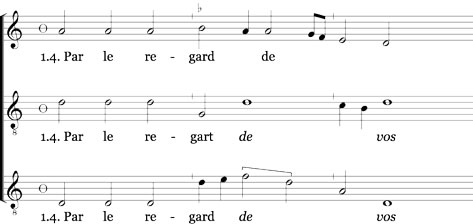Par le regart de vos beaulx yeulx 3v · Guillaume Du Fay
Appearance in the group of related chansonniers:
*Laborde ff. 67v-68 »Par le regart de voz beaulx yeulx« 3v · Edition · Facsimile
*Wolfenbüttel ff. 36v-37 »Par le regart de vos beaulx yeulx« 3v · Edition · Facsimile
Other musical sources:
Berlin 78.C.28 ff. 13v-14 »P« 3v
Copenhagen 17 p. 15 »[Without text]« 1v [3v] (C only)
Escorial IV.a.24 ff. 40v-41 »Par le regard de vous biaux yeulx« 3v
Montecassino 871 p. 266 »Par le regart de vos beaulx yeux« 3v Dufay
Munich 9659 ff. 3v-4 »Par le regart de vous beaulx yeulx« 3v · Facsimile
New Haven 91 ff. 73v-74 »Par le regart de voz beaulx yeulx« 3v Du fay · Facsimile
Paris 15123 ff. 39v-40 »Parleregart devos biaulx yeux« 3v · Facsimile
Pavia 362 ff. 47v-48 »Par le regart de vos beaulx yeulx« 3v
Porto 714 ff. 61v-62 »Per le reguarde vous beaux yeux« 3v Dufay
*Sevilla 5-1-43 f. 49v + Paris 4379 f. 21 »Par le regard de vos beaux yeulx« 3v Dufay (?) · Edition
Trento 93 f. 318v »Resone unice / Porle regart« 3v · Facsimile
This page with editions as a PDF
Citations, intabulations and use of material, see Fallows 1999 p. 307.
Edition: Gutiérrez-Denhoff 1988 no. 28 (Wolfenbüttel).
Text: Rondeau quatrain; full text in Laborde and Wolfenbüttel; also in Pavia 362 and Sevilla 5-1-43; also found in Jardin 1501, f. 77. After Laborde and Wolfenbüttel:
Par le regart de vos beaulx yeulx De vostre amour suis desireux, par le regart de vos beaulx yeulx Or vous plaise, cueur gracieux, Par le regart de vos beaulx yeulx |
By a glance from your beautiful eyes I desire your love, by a glance from your beautiful eyes Now it might please you, gracious heart, By a glance from your beautiful eyes |
1) line 2, Laborde, “de vo maintien tresbel et gent“
2) line 6, Wolfenbüttel, “et tout mon vouloir s‘i consent"
3) Line 10, Laborde, “moy tenir or a present"
Evaluation of the source:
Du Fay’s rondeau had been in the repertory for decades before it reached the two ‘Loire Valey’ chansonniers. At least since the late 1450s when it was entered in MS Trent 93, and it was widely circulated. Disregarding ligatures and coloation, there are so many differences in musical details between the Laborde and Wolfenbúttel chansonniers (see S bb. 2.2-3, 4.2-3, 8.1-3, 9.1-2, 10.3, 15.1-2, 22; T bb. 6.3, 8.1, 12, 14-15; C bb. 5.3, 6.3, 8.1) that obviously they belonged to different traditions of transmission. These differences represent a small part only of those appearing in the many sources for this song. (1)
An interesting variant appears in two sources, Munich, Bayerische Staatsbibliothek, Mus.Ms. 9659, and the chansonnier split between Sevilla, Biblioteca Capitular y Colombina, MS 5-1-43, and Paris, Bibliothèque Nationale, ms. nouv. acq. fr. 4379, which may have displayed Du Fay's name in its cut-off upper margin. In the first bar of the upper voice, the long note is divided up into three semibreves (see the edition of the Sevilla version). This changes the declamation of the poem in a very audible way, and it was something like this version of the song, which Loyset compere knew when he quoted its start in his “Au travail suis” (see further below).
Many of the scribes have been somewhat hesitant about how to indicate the safest start positions by way of hexachordal signatures in order to perform Du Fay’s play with hexachordal positions. In Wolfenbüttel the song is completely without any signatures. This means that the singers have to supply quite many B-flats in all three voices. Laborde has a one flat signature in the tenor and contra. The tenor signature, however, disappears in the second section of the rondeau. In this way there is very little for the singers to decide. This disposition is found also in Munich 9659 and in the chansonnier in Berlin, Staatliche Museen der Stiftung Preußischer Kulturbesitz, Kupferstichkabinett, Ms. 78.C.28. In Sevilla 5-I-43 it has a one flat signature in all voices, making the music slightly monochrome, but not posing any problems for the singers.
Comments on text and music:
A short straightforward poem where a confident lover offers his services; more related to Du Fay’s songs for spring and New Year than to the courtly repertory. It is set for a domineering upper voice closely followed by the tenor and the contratenor, both in the same range a fifth below the superius. It is elegant, varied and uses its range (g-c') to great advantage.
The opening of the upper voice in the Sevilla MS (and Munich 9659) changes the text underlay of the first line radically and influences the character of the song as a whole. The three repeated notes underscores the active thrust of the poem and dispels somewhat the lyrical feeling of the music. As hinted at by David Fallows, (2) this way of performance may have implications for the other versions of the song and the way of singing the lower voices. For example, the Wolfenbüttel version might have been performed as shown in the example below. In any case, this hypothetical version is very close the opening of the song, which Compere quoted in his quodlibet rondeau »Au travail suis sans espoir de confort«, which was copied into the French chansonnier in Florence, Biblioteca Riccardiana, Ms. 2794, a few years after the copying of the Wolfenbüttel chansonnier (see further the edition).

PWCH November 2021
1) For a detailed discussion, see David Fallows, The Songs of Guillaume Dufay. Critical Commentary to the Revision of Corpus Mensurabilis Musicae, ser. 1, Vol. VI (Musicological studies & documents 47), Neuhausen-Stuttgart 1995, pp. 193-200.